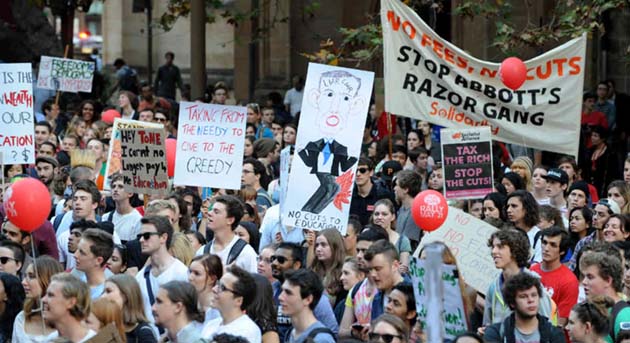Students around the country are celebrating the defeat of the Liberals’ higher education reforms, which would have cut funding by 20 per cent and sent university fees soaring. After a year-long campaign on the campuses, the Senate narrowly voted 33-31 against Education Minister Christopher Pyne’s fee deregulation package.
Pyne’s last minute concessions failed to secure sufficient Senate support. He offered a structural adjustment fund and a five-year interest rate freeze for parents, and promised to ditch the increased interest on HECS debts. But this icing sugar could not disguise the poison pie.
Pyne’s humiliation is a confidence boost for everyone who wants to bust the budget. It shows that Abbott’s deeply unpopular austerity budget can be beaten, and his agenda for higher education crushed.
The student campaign, which brought thousands onto the streets, cemented public opinion against the reforms. It was an antidote to the pro-deregulation propaganda of the government and Universities Australia, the peak body uniting the university bosses, the Vice-Chancellors. By the time it went to the vote, only 23 per cent of people thought the Senate should support the bill.
The fight is not over
But the fight to bury fee deregulation is far from finished. Pyne insists deregulation is “inevitable” and has already reintroduced an amended bill into the lower house, which is expected to come back to the Senate in February. Treasurer Joe Hockey is on record saying that the Liberals could cut government contributions to universities even if deregulation does not get passed.
And the Senate cannot be relied upon. While The Greens and Labor stood firm against the bill, its defeat relied on the votes of loose cannon Jacqui Lambie and unreliable allies Nick Xenophon and Palmer United Party (PUP) senators Glenn Lazarus and Dio Wang.
Xenophon’s opposition seems qualified. He originally wanted to delay the vote, saying the government needed to proceed “cautiously” and even said there was “still time” to discuss potential changes. He conceded that some kind of higher education reform is necessary.
And PUP senator Dio Wang is clearly starting to wobble. He voted against the bill, but has been swayed by Universities Australia’s intense lobbying campaign, saying afterwards that, “All the universities have come out and said they want this in some shape or form. When this happens, you have to listen to their comments”.
Whatever happens in Canberra it’s clear that students and staff will need to keep up the pressure.
Building on 2014 and into the future
To do this we must build the strength of the campaign. At its peak, large rallies following the May budget drew around 7000 students nationwide. Whenever Liberals dared to step onto our campuses students called snap actions to give them the (un)welcome they deserved. And students were not afraid to be public and disruptive, with stunts like the Q&A protest keeping the issue on the agenda.
At some universities like Sydney and ANU, students and staff applied the heat to their Vice-Chancellors. At Sydney, for example, at his “Town Hall-style meeting”, Vice-Chancellor Michael Spence was protested and heckled, and the meeting passed a motion condemning the cuts.
Despite the self-congratulatory assessments of some of the Left, the movement fell a long way short of its potential. The campaign will need to do better if Abbott, Hockey, Pyne and the Vice-Chancellors are going to be pushed back in 2015.
From the high point of the post-budget protest, the rallies rapidly shrank. In NSW, the final National Day of Action of the year consisted of no more than 50 students from the organised left.
The experience at Sydney University was symptomatic of the broader campaign. Here the Education Action Group (EAG) operated as a rally and stunt committee, and did not set out to draw in new activists to sustain the movement beyond the initial gut outrage. At most other campuses in NSW too, EAGs are tiny or non-existent. All of this has reinforced a tendency for the NSW Education Action Network (EAN) to substitute for on-campus activity, and rely on small stunt actions. But stunts alone cannot take movements forward.
We need a mass political student movement that involves a broad layer of new student activists. Students need to be politically confident to lecture bash their own classes and demolish the justifications for cuts coming from the Liberal government and University administrations. We need vibrant campaign groups on the campuses that reach out to and involve fellow students and link up with broader anti-budget actions. In 2015 education activists need to hit the campuses with stalls, public forums and leaflets outlining the fight to come. We should aim for solid student contingents on next year’s March in March demonstrations.
There is every possibility of building a stronger political campaign given the plummeting popularity of the Liberal government, which has over-reached in its attempts to attack education, as well as Medicare, the ABC and public sector jobs. We should take the fight into 2015 to build the kind of education movement capable of hammering the final nail into not just the deregulation coffin but the Abbott government too.
and Erima Dall






